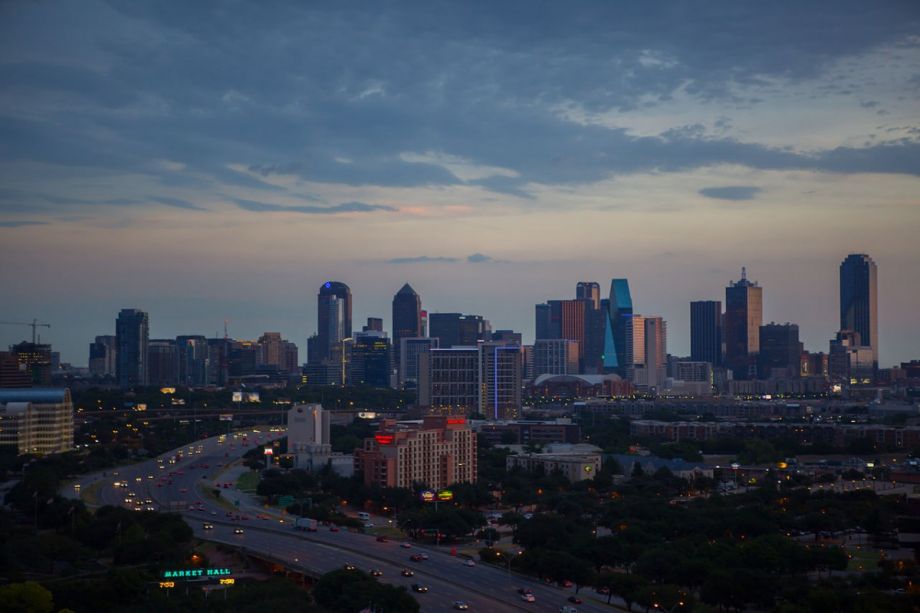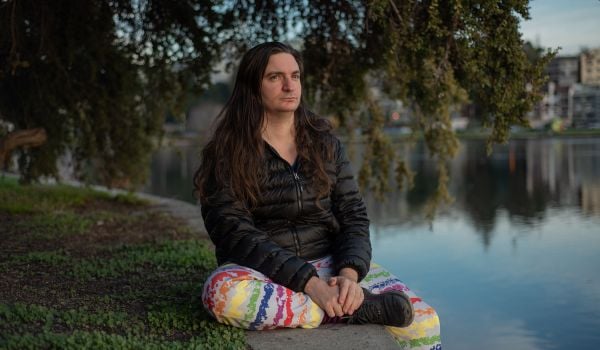This story is published collaboratively with Dallas Free Press as part of the Equitable Cities Reporting Hub for Environmental Justice, an initiative led by Grist and Next City.
Along a stretch of Singleton Road, West Dallas’ major thoroughfare, sits GAF Materials, a large industrial plant that chemically treats fiberglass to make roof shingles.
On one side is a City-owned community center and library. On the other are a dozen or so residential homes and a former public middle school functioning as a waystation for high school students who lost their building in a tornado three years ago.
Across the street is a manmade lake that sits atop a former sand and gravel pit, surrounded by public housing that has a history dating back to the ’50s, when it was the largest federal housing project built to date.
And amid all of this are 26.5 acres that house one of West Dallas’ biggest sources of sulfur dioxide and particulate matter pollution, according to the Texas Commission on Environmental Quality’s 2020 emission inventories. Both substances can harm the lungs.
After nearly 80 years in the West Dallas neighborhood, GAF Materials is beginning the process of closing its facility. Residents pushed to make this happen for years.
Though GAF has acquiesced, the company seems intent to leave on its own terms — a seven-year departure plan that asks the City of Dallas for a zoning change that would upgrade the land use possibilities from a shingle plant to a mix of residences and retail shops.
Neighbors don’t understand why GAF needs so long to leave and question who will truly benefit from a land upgrade. Once again, they have to defend their vision for their neighborhood.
Who benefits from the land: GAF Materials or West Dallas neighbors?
As the Environmental Protection Agency (EPA) reviewed GAF’s federal permit last year, West Dallas neighbors seized the opportunity to flood the Texas Commission on Environmental Quality (TCEQ) with public comments, urging the national and state agencies to show the shingle plant the door.
It took another year before GAF representatives and West Dallas leaders sat down to begin negotiating an exit strategy, but those negotiations didn’t make it past the first meeting.
“GAF broke trust with the community by walking away from the table [in July]. But these are the people they’re going to have to deal with anyway,” said Stephanie Champion — a West Dallas resident who leads Builders of Hope’s neighborhood planning efforts — to GAF representatives at the meeting.
Later that month, GAF announced it would voluntarily cease operations at the West Dallas plant and leave by 2029 — far later than residents say they think is reasonable.
Then in September, GAF filed an application with the City of Dallas to rezone 2600 Singleton Boulevard from “industrial research” to a mixed-use “planned development district,” or PD. GAF’s plant is a nonconforming land use, meaning its manufacturing operation is not allowed under the current zoning but was grandfathered in. The proposed PD would forbid all industrial uses on the property after 2029.
As part of the zoning permit process, GAF needs to show that it has met with the neighborhood and has its support. That means overcoming the distrust inflamed by GAF’s choice to make a unilateral decision rather than following up with July’s community conversations.
So GAF hired communications agency Allyn Media, a known entity in Dallas politics, and zoning consultant Masterplan, a regular player in Dallas land use decisions, to spearhead a series of six meetings with West Dallas residents.

A letter to GAF that was tied to the facility’s fence. (Photo by Sona Chaudhary)
Polluted air and eroded trust
The first meeting took place Nov. 30 at the Anita Martinez Recreation Center in West Dallas. The recreation center is not the closest City facility to GAF; the West Dallas Multipurpose Center is next door to the shingle plant.
Attendees expressed frustration that the meeting location was almost two miles away from the neighborhood GAF is in, and suggested perhaps GAF didn’t want the shingle plant odors to infuse the meetings.
Lee Kleinman, a senior advisor for Masterplan and a former north Dallas City Councilmember, led the discussion. In the back of the room, Jim Schermbeck with environmental advocacy group Downwinders at Risk held a sign calling out Kleinman for voting to relocate the Argos Cement Plant closer to West Dallas homes in 2015.
According to Masterplan’s presentation, GAF’s exit plan has so far been shaped by conversations with the City of Dallas environmental commission, City Council, and West Dallas residents. Kleinman says GAF’s goal is to create a document that the City can enforce to guarantee their exit in seven years.
The company is the largest manufacturer of roof shingles in the United States with 34 manufacturing plants across the country. GAF’s seven-year timeline to exit West Dallas anticipates identifying a site for a new plant, which would be fully constructed by the middle of 2026. The three years after that are dedicated to increasing staffing and shingle production incrementally until the new plant fully replaces the output of the current plant.
GAF promised to reduce its current plant’s raw material production to cut down on pollution. According to their timeline, there will be one reduction at the West Dallas facility in 2022, then no further reductions until 2027.
Once they exit, the land will have to be remediated to make it safe for whoever uses it next. Remediation is not included in the timeline, though GAF’s representatives sats they were committed to site cleanup.
Feuding neighborhood plans
Masterplan is calling GAF’s proposal the “2600 Singleton Vision Plan,” which will outline future land uses that are compatible with the neighborhood.
This comes two years after several neighborhood groups and organizations in West Dallas developed the Singleton Corridor Neighborhood-Led Plan. Its goal is to “use grassroots neighborhood planning as a tool to undo harmful racist zoning that leads to environmental justice crises,” including GAF’s presence in West Dallas.
Several of the groups involved in that plan were part of July’s negotiations, including neighborhood association Singleton United. Janie Cisneros formed Singleton United in 2021 to address the issue of GAF and air pollution affecting 316 homes around the plant. They created a proposal for GAF to shut down operations in West Dallas by the end of 2024.
At the November meeting, Kleinman noted GAF’s 2600 Singleton Vision Plan is based in part on Builders of Hope’s still-in-progress West Dallas Community Vision Plan, which emphasizes local environmental justice concerns. The Builders of Hope plan recommends strategies such as removing environmental hazards and rezoning sites to prohibit further industrial land uses near residential neighborhoods.
GAF believes its zoning change should be supported, in reference to one of its goals to “enhance the quality of life for West Dallas residents.” In recent years, the shingle company stepped up its community impact efforts, according to the description of the Dallas plant that pops up from a map on its website.
Last year GAF gave grants and sponsored events for Brother Bill’s Helping Hand Drive Thru Pantry, the Blue Guardian Foundation, and Lake West Neighborhood Police. In 2020, it worked with a contractor to replace the roof of St. Theresa Church across the street for free. And its employees volunteer with Habitat for Humanity, which is proudly proclaimed by a Habitat sign at GAF’s entrance.
But for neighbors who have lived with decades of pollution, it’s not nearly enough to undo the damage.
“You have a history of privileges this neighborhood does not have … I don’t think you understand the severity of this situation. You’re talking to City Hall but you’re not talking to us, and you haven’t been,” Cisneros said to GAF’s representatives at the meeting.
“We’re inhaling poison in the air every day. You’re asking us to sacrifice ourselves so your business isn’t disrupted.”
A gentrifying neighborhood
In the 80 years GAF has operated in West Dallas, the significance of investing in the neighborhood has changed. Outside investors have brought an influx of money and development as growth extends from Downtown Dallas.
In 2019 Ray Washburne, co-owner of the Highland Park Village shopping center in the city’s wealthiest neighborhood, purchased the shopping center on the northwest corner of Singleton Boulevard and Hampton Road across from GAF. A new grocery store opened there six months later, and an estimated $1 billion in development has since come into the area.
In this historically redlined neighborhood, whose residents are 60% Hispanic and 30% Black with an average household income of $47,461, land values are on the rise and likely to keep increasing.
GAF is proposing a PD that would be zoned MU-3, which is a mixed use designation typically for retail, office, hotel and apartments. While this would make it likely that GAF’s land would be redeveloped, the new buyer would be the one to ultimately decide what happens there.
“Why are we dealing with a zoning issue that will eventually, when you leave in 2029, when you sell — the person who purchases this land might have a whole different plan?” Raul Reyes Jr., president of grassroots neighborhood coalition West Dallas 1, asked GAF representatives during their presentation.
Frustrations eventually sunk the meeting. About 20 minutes into Masterplan’s presentation, most people in the room walked out.
“The only way to turn this around is for the company to negotiate in good faith with its neighbors. This was presented as a done deal. It was not a negotiation,” Cisneros said in a statement from Singleton United/Unidos following the meeting.
What comes next for GAF and West Dallas
Community meetings will continue through spring 2023. The next one is scheduled for Jan. 11 at 6:30 pm at the Nash-Davis Recreation Center; the topic is GAF’s polluting emissions.
Even on this front, the “facts” are feuding. Based on a stack test performed by Air Hygiene from Sept. 20-22, GAF maintains that it has reduced sulfur dioxide emissions at the plant by more than 60%. These results classify it as a “minor emissions source” that now only needs a state permit to operate instead of a federal one.
These claims came after the EPA told TCEQ it opposed issuing GAF a new permit because of their historically sparse testing and monitoring standards.
Meanwhile, Downwinders at Risk asserts that even with GAF’s emission reduction, it will still be the biggest source of sulfur dioxide pollution in Dallas County. Both EPA and Downwinders at Risk also called out the significance of other types of pollution coming from the GAF plant, such as particulate matter and Volatile Organic Compounds, which are pollutants that also have long histories of harming human health.
Within the city’s zoning change process, the next steps will be to solicit comments from nearby property owners and city departments. GAF’s timeline anticipates their request ultimately reaching the appointed City Plan Commission for consideration in summer 2023, then head to City Council for a final decision in fall 2023. Both votes require public hearings before a decision is made.
However, just last week, the City Plan Commission approved a request from West Dallas residents for an authorized hearing to determine the Singleton Corridor’s future zoning. Authorized hearings are a way for the city to consider zoning changes for a property without requiring an application from the property’s owners.
Now that the hearing is approved, Singleton United will advocate for its own neighborhood plan to close GAF much sooner, as well as to rezone other parts of the Singleton Corridor to eliminate the potential for future industrial uses. These comments will reach City Hall right around the time that GAF’s rezoning proposal will be under consideration.
Sona Chaudhary is a reporter at the Dallas Free Press. She reports on issues of systemic inequity and amplifies community voices in disinvested Dallas neighborhoods.
















